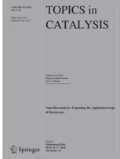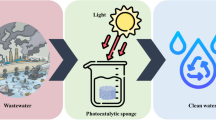Abstract
In this work principal component analysis (PCA) was used to study the effect of batch, reduction temperature, TiO2 content and UV-C irradiation on the surface energy, -polarity and interlayer spacing of photoactive TiO2/GO composite membranes. Two PCA models were successfully developed. The first PCA model shows a negative correlation between reduction temperature and d-spacing. Less hydrophilic TiO2/GO membranes were obtained at 160 °C compared to membranes reduced at 140 °C. Also, the surface polarity and surface energy were significantly enhanced by the addition of higher TiO2 content. The second model explain the effect of UV-C activation on the surface energy of the TiO2/GO composite membranes. For the GO membranes containing TiO2 a significant increase in surface energy and -polarity was observed after UV-C activation. Moreover, a positive correlation between the TiO2 content and surface energy after UV-C activation was observed. Higher TiO2 content results in higher surface energy. GO batches prepared by different groups was not found to significantly affect the properties of the TiO2/GO composite membranes suggesting that the preparation method is relative robust.






Similar content being viewed by others
References
Bui X-T, Chiemchaisri C, Fujioka T, Varjani S (2019) Introduction to recent advances in water and wastewater treatment technologies. In: Agarwal AK, Pandey A (eds) Water and wastewater treatment technologies, 1st edn. Springer, Singapore, pp 3–12
Nam S-W, Jo B-I, Yoon Y, Zoh K-D (2013) Occurrence and removal of selected micropollutants in a water treatment plant. Chemosphere 95:156–165
Sikdar SK, Criscuoli A (2017) Sustainability and how membrane technologies in water treatment can be a contributor. In: Figoli A, Criscuoli A (eds) Sustainable membrane technology for water and wastewater treatment, 1st edn. Springer, Singapore, pp 1–21
Van Der Bruggen B, Vandecasteele C (2003) Removal of pollutants from surface water and groundwater by nanofiltration: overview of possible applications in the drinking water industry. Environ Pollut 122:435–445
Mehta R, Brahmbhatt H, Saha NK, Bhattacharya A (2015) Removal of substituted phenyl urea pesticides by reverse osmosis membranes: laboratory scale study for field water application. Desalination 358:69–75
Jhaveri JH, Murthy Z (2016) A comprehensive review on anti-fouling nanocomposite membranes for pressure driven membrane separation processes. Desalination 379:137–154
Pedersen MLK, Jensen TR, Kucheryavskiy SV, Simonsen ME (2018) Investigation of surface energy, wettability and zeta potential of titanium dioxide/graphene oxide membranes. J Photochem Photobiol A Chem 366:162–170
Athanasekou CP, Morales-Torres S, Likodimos V, Romanos GE, Pastrarna-Martinez LM, Falaras P, Dionysiou DD, Faria JL, Figueiredo JL, Silva AMT (2014) Prototype composite membranes of partially reduced graphene oxide/TiO2 for photocatalytic ultrafiltration water treatment under visible light. Appl Catal B Environ 158–159:361–372
Chen L, Shi G, Shen J, Peng B, Zhang B, Wang Y, Bian F, Wang J, Li D, Qian Z, Xu G, Liu G, Zeng J, Zhang L, Yang Y, Zhou G, Wu M, Jin W, Li J, Fang H (2017) Ion sieving in graphene oxide membranes via cationic control of interlayer spacing. Nature 550:380–383
Werber JR, Osuji CO, Elimelech M (2016) Materials for next-generation desalination and water purification membranes. Nat Rev Mater 1:1–15
Kumar R, Singh RK, Kumar V, Moshkalev SA (2018) Functionalized nanosize graphene and its derivatives for removal of contaminations and water treatment. In: Naushad M (ed) A new generation material graphene: applications in water technology, 1st edn. Springer, Cham, pp 133–185
Yu W, Yu T, Graham N (2017) Development of a stable cation modified graphene oxide membrane for water treatment. 2D Mater 4:1–14
Sengupta I, Chakraborty S, Talukdar M, Pal SK (2018) Thermal reduction of graphene oxide: how temperature influences purity. Mater Res Soc 33:4113–4122
Wei Y, Zhang Y, Gao X, Ma Z, Wang X, Gao C (2018) Multilayered graphene oxide membrane for water treatment: a review. Carbon 139:964–981
Alhadhrami A, Salgado S, Maheshwari V (2016) Thermal reduction to control the spacing in graphene oxide membranes: effect on ion diffusion and electrical conduction. R Soc Chem 6:70012–70017
Yang E, Ham MH, Park HB, Kim CM, Song JH, Kim IS (2018) Tunable semi-permeability of graphene-based membranes by adjusting reduction degree of laminar graphene oxide layer. J Membr Sci 547:73–79
Homaeigohar S, Elbahri M (2017) Graphene membranes for water desalination. NPG Asia Mater 9:427–427
Safarpour M, Vatanpour V, Khataee A, Esmaeili M (2015) Development of a novel high flux and fouling-resistant thin film composite nanofiltration membrane by embedding reduced graphene oxide/TiO2. Sep Purif Technol 154:96–107
Zhu C, Liu G, Han K, Ye H, Wei S, Zhou Y (2017) One-step facile synthesis of graphene oxide/TiO2 composite as efficient photocatalytic membrane for water treatment: crossflow filtration operation and membrane fouling analysis. Chem Eng Process Process Intensif 120:20–26
Safarpour M, Khataee A, Vatanpour V (2015) Thin film nanocomposite reverse osmosis membrane modified by reduced graphene oxide/TiO2 with improved desalination performance. J Membr Sci 489:43–54
Khataee AR, Safarpour M, Zarei M, Aber S (2012) Combined heterogeneous and homogeneous photodegradation of a dye using immobilized TiO2 nanophotocatalyst and modified graphite electrode with carbon nanotubes. J Mol Catal A Chem 363–364:58–68
Štengl V, Bakardjieva S, Grygar TM, Bludská J, Kormunda M (2013) TiO2-graphene oxide nanocomposite as advanced photocatalytic materials. Chem Cent J 7:1–12
Tayel A, Ramadan AR, El Seoud OA (2018) Titanium dioxide/graphene and titanium dioxide/graphene oxide nanocomposites: synthesis, characterization and photocatalytic applications for water decontamination. Catalysts 8:491–535
Banerjee S, Dionysiou DD, Pillai SC (2015) Self-cleaning applications of TiO2 by photo-induced hydrophilicity and photocatalysis. Appl Catal B Environ 176–177:396–428
Simonsen ME, Li Z, Søgaard EG (2009) Influence of the OH groups on the photocatalytic activity and photoinduced hydrophilicity of microwave assisted sol-gel TiO2 film. Appl Surf Sci 255:8054–8062
Liu J, Bai H, Wang Y, Liu Z, Zhang X, Sun DD (2010) Self-assembling TiO2 nanorods on large graphene oxide sheets at a two-phase interface and their anti-recombination in photocatalytic applications. Adv Funct Mater 20:4175–4181
Naghdi S, Jaleh B, Shahbazi N (2016) Reversible wettability conversion of electrodeposited graphene oxide/titania nanocomposite coating: investigation of surface structures. Appl Surf Sci 368:409–416
Marcano DC, Kosynkin DV, Berlin JM, Sinitskii A, Sun Z, Slesarev A, Alemany LB, Lu W, Tour JM (2010) Improved synthesis of graphene oxide. ACS Nano 4:4806–4814
Simonsen ME, Jensen H, Li Z, Søgaard EG (2008) Surface properties and photocatalytic activity of nanocrystalline titania films. J Photochem Photobiol A Chem 200:192–200
Owens DK, Wendt RC (1969) Estimation of the surface free energy of polymers. J Appl Polym Sci 13:1741–1747
Fowkes FM (1964) Attractive forces at interfaces. Ind Eng Chem 56:12, 40–52
Esbensen KH, Geladi P (2009) Principal component analysis: concept, geometrical interpretation, mathematical background, algorithms, history, practice. In: Comprehensive chemometrics: chemical and biochemical data analysis. Elsevier, Amsterdam, pp 211–226
Guardia L, Villar-Rodil S, Paredes JI, Rozada R, Martín-Alonso A, Tasón JMD (2012) UV light exposure of aqueous graphene oxide suspensions to promote their direct reduction, formation of graphene-metal nanoparticle hybrids and dye degradation. Carbon 50:1014–1024
Williams G, Seger B, Kamat PV (2008) TiO2-graphene nanocomposites. UV-assisted photocatalytic reduction of graphene oxide. ACS Nano 2:1487–1491
Szabó T, Veres Á, Cho E, Khim J, Vargo N, Dékány I (2013) Photocatalyst separation from aqueous dispersion using graphene oxide/TiO2 nanocomposites. Colloids Surf A Physicochem Eng Asp 433:230–239
Singh R (2014) Membrane technology and engineering for water purification: application, systems design and operation, 2nd edn. Elsevier, Amsterdam
Lundstrom I (1983) Surface physics and biological phenomena. Phys Scr 4:5–13
Author information
Authors and Affiliations
Corresponding author
Ethics declarations
Conflict of interest
The authors declare that they have no conflict of interest.
Ethical Approval
This paper does not contain any studies with human participants or animals performed by any of the authors.
Informed Consent
None.
Additional information
Publisher's Note
Springer Nature remains neutral with regard to jurisdictional claims in published maps and institutional affiliations.
Rights and permissions
About this article
Cite this article
Simonsen, K.R., Sharker, T., Rask, M. et al. Principal Component Analysis of the Effect of Batch Variation, TiO2 Content and Reduction Temperature on the Surface Energy of TiO2/Graphene Oxide Membranes upon UV-C Activation. Top Catal 64, 806–816 (2021). https://doi.org/10.1007/s11244-020-01296-x
Published:
Issue Date:
DOI: https://doi.org/10.1007/s11244-020-01296-x




